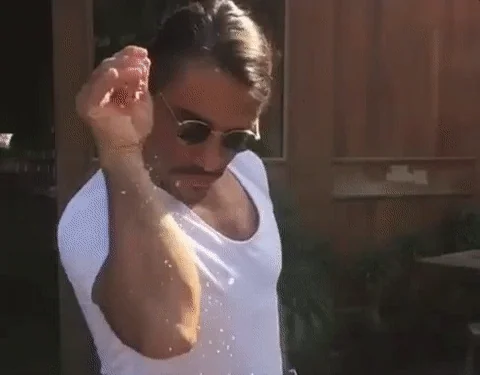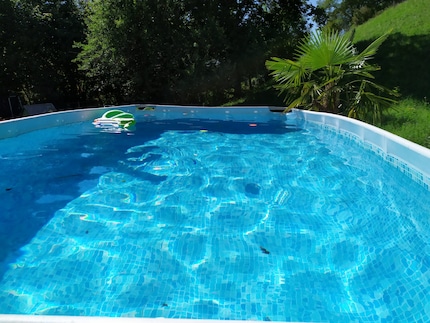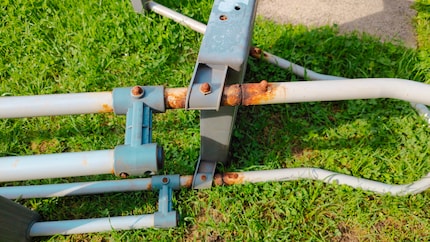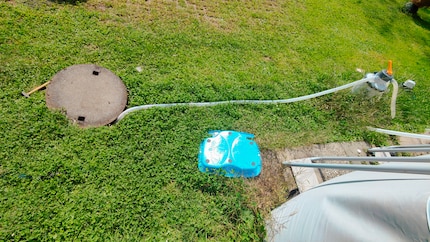

Saltwater swimming pool – our own little Baltic Sea in the garden
My time as a fresh-water pirate in our above-ground pool is finally over. How come? I tried out using saltwater in combination with a chlorinator and discovered that the advantages far outweigh the disadvantages – despite rusty side effects.
Quatorze Juillet or 14 July. This year, we set up the pool in our garden on the national day of France. As late as never before.
And today, just two months later, it already looks like the swimming season’s over again. In other words, I need to figure out how to get rid of about 10,000 litres of saltwater in the most environmentally friendly way. That’s right, I salted our pool water this year to keep it clean and hygienic. And I’m so happy with the result I’m never going back to fresh water again. But let’s take it one step at a time.

Source: Giphy
Turning salt into chlorine
Most of the earth’s surface is covered with saltwater. The salt content varies greatly depending on the sea. The Mediterranean, for instance, has a salt content of between 3.6 and 3.9%; the Baltic Sea between 0.3 and 1.8% and the Dead Sea almost 30%.
I poured about 30 kilogrammes of salt into our above-ground swimming pool at the start of the season. That’s three kilogrammes per 1,000 litres of water, resulting in a salt content of only 0.3%. We could taste the salt slightly, but it wasn’t salty enough to feel like the sea. Which it didn’t need to either.

In fact, salt’s only there to make sure the chlorinator can do its work. The small appliance’s attached between the sand filter pump and the pool. Switch it on and it turns the salt in the water into chlorine. Or to put it in more technical and chemical terms: when the chlorinator’s running, an electrolytic cell inside the appliance causes a chemical reaction that converts sodium chloride (salt) into sodium hypochlorite (chlorine bleach).
This produces liquid chlorine – although, strictly speaking, it’s not elemental chlorine. What’s special about this process is that it turns back into sodium chloride after the sodium hypochlorite has developed its purifying effect. This means the salt in the pool water’s retained and can be continuously reused.
But what about the kids and red eyes?!
Yes, many people find chlorine irritating – literally. Personally it makes me think of that typical, pungent smell and red, itchy eyes. On the other hand, chlorine’s undoubtedly an effective long-term disinfectant, which keeps water clean and hygienic. And it’s quite cheap and, above all, readily available. This is why it’s used in most outdoor and indoor swimming pools.
Until this year, we’ve kept our pool chlorine-free and used other chemicals such as bromine and algaecides – not least for the sake of our five-year-old daughter. That’s why I initially had some reservations about the chlorinator. However, I was proven wrong in no time. None of us had red eyes or other negative side effects after splashing around in our salty pool. How come? Well, the chlorine produced by saltwater is less aggressive than conventional chlorine. And our pool didn’t smell of chlorine as strongly as large public swimming pools either.
Nevertheless, the method fulfilled its purpose perfectly. The water stayed clean throughout the season – apart from the insects on the surface and coarser dirt particles at the bottom, which we tackled with nets and a pool vacuum. After all, chlorine can’t keep everything away.
One time, the pool was left covered for almost three weeks because the weather wasn’t good enough to go swimming. I left the chlorinator running overnight during this time, but still feared the worst when I lifted the pool cover after such a long time. But even after three weeks, the water was clean and the pool walls were free of algae.

Source: Patrick Vogt
Little maintenance work during the season
Sure, the pool season 2024 was rather short, but the chlorinator only complained once about the salt content in the water being too low. This can, of course, happen due to evaporation and refilling of fresh water. So I poured in another five to seven kilogrammes of salt and the appliance was happy again.
The electrolytic cell of the chlorinator requires some care. Over time, limescale builds up on the electrodes, which impairs chlorine production. That’s why I activated its automatic self-cleaning function from time to time. I also treated the electrolytic cell with vinegar after the season came to an end to really get rid of all the deposits.
The only thing I regularly checked during the season was the pH value of the water. However, that’s something every pool owner should do, no matter if it’s a fresh or saltwater type. The pH value’s important to make sure chlorine and other chemicals can fully develop their disinfecting effect. Editorial colleague and pool boy Martin Jungfer wrote about the importance of the correct pH value here:
Rusty ladder and water disposal
The metallic pool components were less pleased with the salty water, as it causes corrosion. The ladder to get in and out of the pool suffered particularly badly. I’ll have to come up with a new idea next year. This ladder definitely can’t be used again. If only I’d thought of that earlier.

Source: Patrick Vogt
What turned out to be easy was getting rid of all that saltwater. In fact, I did what I do every year – I drained it into the sewer. There’s a direct access point in our garden, which is handy. Apart from that, I always stick to what pool boy Martin summarised here when it comes to disposing of pool water.

Source: Patrick Vogt
See you next year, saltwater pool!
Apart from the rusty ladder, I’m completely satisfied with our saltwater pool experience. I wouldn’t want to do without the services of the chlorinator and will continue to use it in the future. It probably won’t save me any money. In fact, the additional electricity consumption and recurring costs such as salt probably make it a bit more expensive than having a fresh water pool. But it’s worth it to me, as it means I have no other maintenance work to do throughout the pool season. And we have clean pool water at all times.
Do you have experience with saltwater pools with a chlorinator and have any more tips and tricks for newbies like me? The Community and I look forward to your comments.
I'm a full-blooded dad and husband, part-time nerd and chicken farmer, cat tamer and animal lover. I would like to know everything and yet I know nothing. I know even less, but I learn something new every day. What I am good at is dealing with words, spoken and written. And I get to prove that here.
Interesting facts about products, behind-the-scenes looks at manufacturers and deep-dives on interesting people.
Show allThese articles might also interest you

Background information
Chopping boards: wood or plastic, that is the question here
by Martin Rupf

Product test
Kicking out the cartridge: this sand filter pump now cleans our pool water
by Martin Jungfer

Guide
Sheets, nets, chemicals – watery fun in the garden is keeping this amateur pool boy on his toes
by Martin Jungfer

